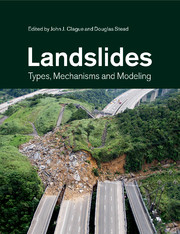Book contents
- Landslides
- Landslides
- Copyright page
- Contents
- Contributors
- Preface
- 1 Landslide hazard and risk
- 2 Landslides in the Earth system
- 3 Earthquake ground motion and patterns of seismically induced landsliding
- 4 Landslides at stratovolcanoes initiated by volcanic unrest
- 5 Mobility of long-runout rock avalanches
- 6 Rapid rock-slope failures
- 7 Risk assessments for debris flows
- 8 Landslides in quick clay
- 9 Controls on the distribution of major types of submarine landslides
- 10 Tsunami hazard assessment related to slope failures in coastal waters
- 11 Physical impacts of climate change on landslide occurrence and related adaptation
- 12 Landslides and geologic environments
- 13 Numerical modeling of rock-slope instability
- 14 Remote sensing techniques and landslides
- 15 Engineering geomorphology of landslides
- 16 Developments in landslide runout prediction
- 17 Models of the triggering of landslides during earthquakes
- 18 Slow rock-slope deformation
- 19 Landslide monitoring:
- 20 Groundwater in slopes
- 21 Soil slope stabilization
- 22 Rockfall characterization and modeling
- 23 The 2006 Eiger rockslide, European Alps
- 24 Randa:
- 25 Characterization and management of rockslide hazard at Turtle Mountain, Alberta, Canada
- 26 The Åknes rockslide, Norway
- 27 A seismometric approach for back-analyzing an unusual rockfall in the Apennines of Italy
- 28 Downie Slide, British Columbia, Canada
- 29 The 1963 Vaiont landslide, Italy
- 30 Hong Kong landslides
- 31 Landslides induced by the Wenchuan earthquake
- 32 Landslides on other planets
- Index
19 - Landslide monitoring:
The role of investigative monitoring to improve understanding and early warning of failure
Published online by Cambridge University Press: 05 May 2013
- Landslides
- Landslides
- Copyright page
- Contents
- Contributors
- Preface
- 1 Landslide hazard and risk
- 2 Landslides in the Earth system
- 3 Earthquake ground motion and patterns of seismically induced landsliding
- 4 Landslides at stratovolcanoes initiated by volcanic unrest
- 5 Mobility of long-runout rock avalanches
- 6 Rapid rock-slope failures
- 7 Risk assessments for debris flows
- 8 Landslides in quick clay
- 9 Controls on the distribution of major types of submarine landslides
- 10 Tsunami hazard assessment related to slope failures in coastal waters
- 11 Physical impacts of climate change on landslide occurrence and related adaptation
- 12 Landslides and geologic environments
- 13 Numerical modeling of rock-slope instability
- 14 Remote sensing techniques and landslides
- 15 Engineering geomorphology of landslides
- 16 Developments in landslide runout prediction
- 17 Models of the triggering of landslides during earthquakes
- 18 Slow rock-slope deformation
- 19 Landslide monitoring:
- 20 Groundwater in slopes
- 21 Soil slope stabilization
- 22 Rockfall characterization and modeling
- 23 The 2006 Eiger rockslide, European Alps
- 24 Randa:
- 25 Characterization and management of rockslide hazard at Turtle Mountain, Alberta, Canada
- 26 The Åknes rockslide, Norway
- 27 A seismometric approach for back-analyzing an unusual rockfall in the Apennines of Italy
- 28 Downie Slide, British Columbia, Canada
- 29 The 1963 Vaiont landslide, Italy
- 30 Hong Kong landslides
- 31 Landslides induced by the Wenchuan earthquake
- 32 Landslides on other planets
- Index
Summary
Recent years have seen significant advances in landslide monitoring technologies. Satellite and ground-based radar systems have considerably increased the areal coverage and spatial resolution of surface displacement monitoring data. Nanotechnology has led to the development of smaller, cheaper, more reliable, and more functional borehole sensors that, together with wireless data acquisition and transmission, have significantly increased the temporal resolution of subsurface slope deformation and microseismic monitoring data. These tools provide increased capacity to detect pre-failure indicators and changes in landslide behavior. Yet the interpretation of slope monitoring data for the purpose of early warning still remains largely subjective, as geologic complexity and uncertainty continue to pose major challenges. To be effective, predictive early-warning monitoring must be preceded by investigative monitoring to provide an understanding of slope behavior over time and typical responses to external stimuli such as precipitation. This chapter reviews several recent developments in landslide monitoring technologies. It discusses the role of investigative monitoring in developing slope monitoring programs and providing early-warning alert levels. Examples are provided from several recent experimental studies involving in-situ rockslide laboratories, in which detailed instrumentation systems and numerical modeling have been used to better understand the mechanisms controlling pre-failure deformations over time and their evolution leading to catastrophic failure. These examples demonstrate that by better integrating different datasets, geologic uncertainty can be minimized and better controlled to provide improved interpretation of slope monitoring and early-warning data.
- Type
- Chapter
- Information
- LandslidesTypes, Mechanisms and Modeling, pp. 222 - 234Publisher: Cambridge University PressPrint publication year: 2012
- 11
- Cited by

